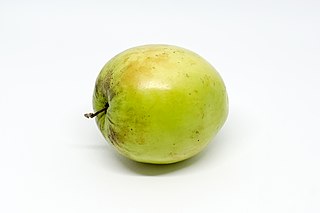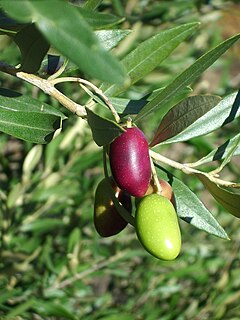
The olive, botanical name Olea europaea, meaning 'European olive' in Latin, is a species of small tree or shrub in the family Oleaceae, found traditionally in the Mediterranean Basin. When in shrub form, it is known as Olea europaea 'Montra', dwarf olive, or little olive. The species is cultivated in all the countries of the Mediterranean, as well as in Australia, New Zealand, North and South America and South Africa. Olea europaea is the type species for the genus Olea.

Rambutan is a medium-sized tropical tree in the family Sapindaceae. The name also refers to the edible fruit produced by this tree. The rambutan is native to Southeast Asia. It is closely related to several other edible tropical fruits including the lychee, longan, pulasan and guinep.

Prunus cerasus is a species of Prunus in the subgenus Cerasus (cherries), native to much of Europe and southwest Asia. It is closely related to the sweet cherry, but has a fruit that is more acidic. Its sour pulp is edible.

Ziziphus mauritiana, also known as Indian jujube, Indian plum, Chinese date, Chinese apple, ber, and dunks is a tropical fruit tree species belonging to the family Rhamnaceae. It is often confused with the closely related Chinese jujube, but whereas Z. jujuba prefers temperate climates, Z. mauritiana is tropical to subtropical.

The hybrid elm cultivar Ulmus × hollandica 'Pioneer' is an American clone arising from the crossing of two European species, Wych Elm U. glabra and Field Elm U. minor. Raised by the USDA station at Delaware, Ohio, in 1971, 'Pioneer' was released to commerce in 1983.

An apple is an edible fruit produced by an apple tree. Apple trees are cultivated worldwide and are the most widely grown species in the genus Malus. The tree originated in Central Asia, where its wild ancestor, Malus sieversii, is still found today. Apples have been grown for thousands of years in Asia and Europe and were brought to North America by European colonists. Apples have religious and mythological significance in many cultures, including Norse, Greek, and European Christian tradition.

The Bosana is the most common cultivar of olives in Sardinia. It makes up over 50% of the olive production on the island. The etymology of the name is uncertain, but it could refer to an alleged origin in the territory of Bosa. It is maintained, however, that the cultivar is of Spanish origin. It is used primarily for oil, but can also be eaten. The Bosana is a variety well adapted to less hospitable environments.

The Lucques is a cultivar of olives grown primarily in Languedoc in France. It is primarily used as a green table olive. It can also produce high quality oil, but this is hard to extract. Though vulnerable to certain pests, it is relatively resistant to cold and drought.

The Aglandau is one of the more important of approximately a hundred cultivars of olives in France. It is grown primarily in Provence, but also as far away as Azerbaijan and Ukraine. The 'Aglandau' is primarily used for production of oil, but can also be eaten. When used as table olives, the fruit is normally called Beruguette. The oil is highly valued for its fruity taste.
The Salonenque, carrying the name of Salon-de-Provence, is a cultivar of olives grown primarily in Provence. Though it is used for producing oil, and gives a good yield, it is valued primarily as a table olive. It is produced as a so-called cracked olive, which means that the fruit is cracked to speed up the curing process.

The Picholine is a French cultivar of olives. It is the most widely available cultivar in France. Though originally from Gard in southern France, it is today grown all over the world. The Picholine is best known as a cocktail olive, though it is also used to make olive oil. It is the most common variety of olive used for oil from Morocco.
The Olivière is a cultivar of olives grown primarily in the Pyrénées-Orientales region of southern France, where it is the most prevalent variety of olives. It is highly valued for its exceptionally high tolerance to cold. The Olivière is primarily used for oil, and even though the fruit yields a low percentage, the trees carry large quantities of olives, and the oil is of high quality.

The Tanche, probably the best known French olive cultivar, is grown primarily in the Drôme and Vaucluse regions of southern France. It is often referred to as a perle noire, the "Black Pearl of Provence". The Tanche is said to have been introduced to France by the Greeks of Massilia, around the fourth century BC.
The Bouteillan is a cultivar of olives grown primarily in Provence. Originally from the town of Aups in the Var département, it is today grown also in Australia and the United States. It is mostly used for the production of oil. The Bouteillan is vulnerable to certain pests, but has a good resistance to cold.

The Cailletier, also known in English by the Italian name Taggiasca, is a cultivar of olives grown primarily in the Alpes-Maritimes region near Nice and the Riviera di Ponente, Italy. It is best known under the name Niçoise, which signifies its curing method. It is commonly used as an important ingredient in the salade niçoise. It can also be used for the production of oil. This cultivar is particularly susceptible to the olive fruit fly.

The Grossane is a cultivar of olives grown primarily in the Vallée des Baux and Bouches-du-Rhône regions of southern France. Though it can be used to produce oil, it is primarily used as a black table olive. Vulnerable to certain biological pests, it is highly resistant to cold and drought.
The Germaine, also Ghjermana, Ghermana, Germana, and sometimes as Romana, is a cultivar of olives grown primarily in Corsica, but also in parts of northern Italy. Genetically it is close to the cultivar Frantoio, that is grown in the Italian region of Tuscany. The Germaine has a good yield of oil, and the plant is resistant to cold weather.
The Cayon is a cultivar of olives grown primarily in the Var region of southern France. It is used primarily for the production of olive oil. The Cayon is highly valued for its role as a pollinator of other olive varieties.

The Leccino olive is one of the primary olive cultivars used in the production of Italian olive oil. Across Italy, it is one of the primary olive cultivars found in olive groves. It is believed to have originated in Tuscany, and it is now grown all over the world. Due to its delicate flavor, the olive oil it produces is commonly blended with Frantoio, Coratina, Moraiolo and Pendolino in order to create more flavor.

Manzanilla olives ("man-zah-nee-ya") or Manzanillo, also Manzanilla de Sevilla, originally from the area of Seville, Spain, are sometimes referred to as Spanish olives but along with Arbosana, Arbequina, Cacereña, Hojiblanca, Empeltre, and Gordal there are over two hundred varieties grown in Spain as well as other areas.















